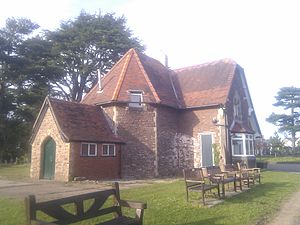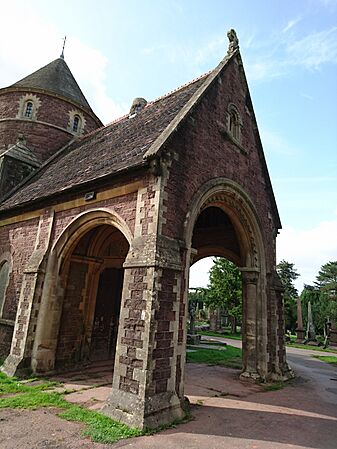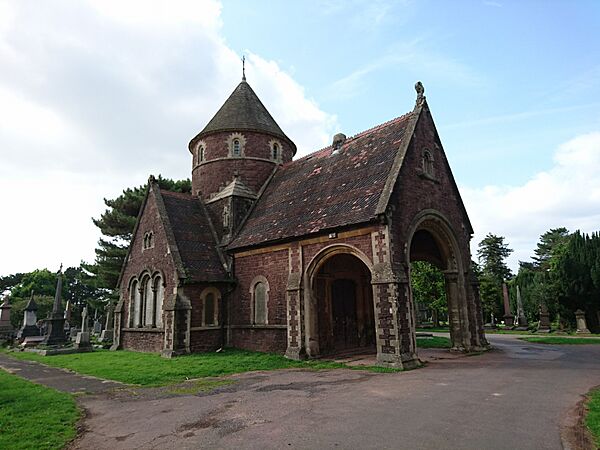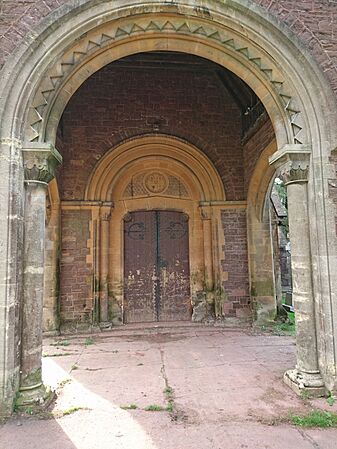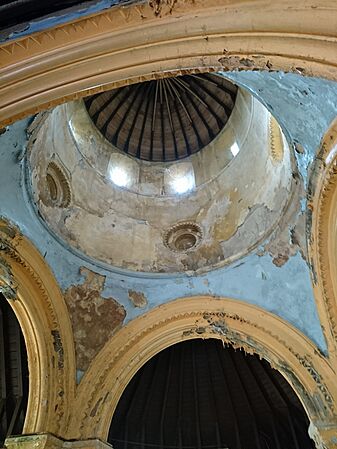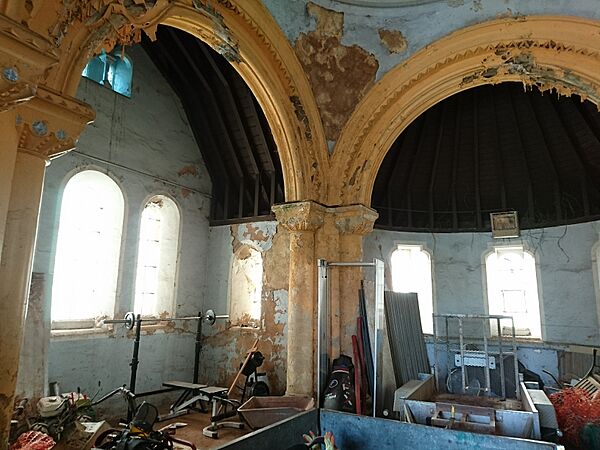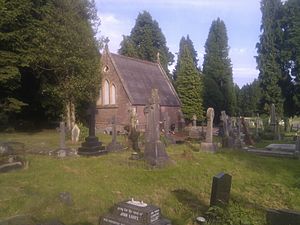St Woolos Cemetery facts for kids
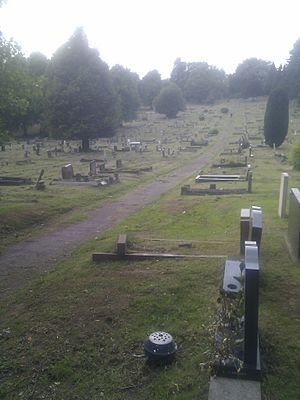
Path within the older part of the cemetery
|
|
| Details | |
|---|---|
| Established | 1854 |
| Location |
48 Bassaleg Road, Newport, NP20 3PY
|
| Country | Wales |
| Owned by | Newport City Council |
| Size | 14 acres (5.7 ha) |
St Woolos Cemetery, officially known as Newport and St Woolos New Cemetery, is the main burial ground in Newport, Wales. It's about a mile west of the famous St Woolos Cathedral. This historic cemetery has four chapels and many beautiful memorials from the Victorian era. It was actually the first cemetery in England and Wales built and managed by a city council! People still use it for burials today. You might even recognize it from the BBC show Doctor Who, as it's been a filming spot! It's also recognized as a special historic park and garden in Wales.
Contents
A Look Back at St Woolos Cemetery
In the early 1800s, the graveyard around St Woolos Cathedral became very crowded. There wasn't enough space for new burials, which caused health concerns. In 1842, a new cemetery opened nearby on Clifton Road, but it also filled up quickly.
To solve this problem, land was bought from the Tredegar Estate. A brand new cemetery was built, becoming the first one in Britain managed by a city council. The very first burial here was a sailor named Cooper on July 1, 1854.
The old cathedral graveyard stopped being used for new burials in 1866. Other chapels in town also closed their graveyards by 1869. From then on, St Woolos Cemetery was the main place for burials in Newport. Later, a second public cemetery opened in Christchurch, Newport in 1883.
Historic Buildings at St Woolos Cemetery
St Woolos Cemetery is listed on the Cadw/ICOMOS Register of Parks and Gardens of Special Historic Interest in Wales. This means it's a very important historic site. It has several old buildings, mostly from the Victorian period.
The Cemetery Lodge
The original lodge was finished in 1855. It's made of stone with special details around the windows. A blue plaque on the wall honors artist James Flewitt Mullock, who also worked for the cemetery board.
This building is now used as the cemetery office. It's located at the main entrance on Bassaleg Road. There's a newer lodge on Risca Road, but it's not a historic listed building.
Anglican Chapel
This chapel has a Gothic style, with a columned entrance. It's one of two similar chapels that face each other near the main entrance. The Anglican chapel is the one on the east side. It has a pointed archway, like those found in Gothic buildings. Above the arch, there's a space for a statue, but it's empty. The chapel has a small bell on its roof. It was used as a chapel until 1997.
Non-conformist Chapel
This chapel has a Romanesque style and is the western building of the two chapels at the main entrance. While it's similar in size to the Anglican chapel, it looks quite different. It has a unique round tower with a cone-shaped roof. Its entrance features a rounded arch with a "dog's tooth" pattern, which is typical of Norman style. The roof also has a decorative pattern using different shaped tiles. Like the Anglican Chapel, this building was used until 1997.
Roman Catholic Chapel
This chapel stands by itself in the cemetery. Its windows were bricked up by September 2015. It was recorded as "disused" in 1997.
Synagogue and Jewish Burial Ground
The Synagogue and an older Jewish cemetery are just outside the main cemetery, in Coed-Melyn Park. The synagogue entrance is on Risca Road. This small, eight-sided building is an addition to an older Jewish chapel that opened in 1871. Its small stained-glass windows feature the Star of David. Behind the synagogue is the burial ground with large gravestones, many with Hebrew writing. It includes Commonwealth war graves for an airman and three soldiers from World War II.
A survey in 2007 showed the inside of the building was well kept. However, in 2013, the sacred Sifrei Torah scrolls from this community were given to an Israeli Jewish community. A request was made in June 2017 to find a new use for the building, as it is no longer in use.
There is also a newer Jewish burial ground inside the main cemetery. It has a small, red-brick chapel and is surrounded by a tall fence. This newer area is not a listed historic structure.
Mortuary Chapel
The Mortuary Chapel is also a Grade II listed building. It's located between the Bassaleg Road and Risca Road entrances. Unlike other chapels, you entered this one through a side door. It has round "rose windows" on each end, which used to let in light but are now boarded up. This chapel is no longer used for its original purpose and is showing signs of wear.
Eastern Entrance
The gates, pillars, and walls at the main entrance from Bassaleg Road are also listed as historic. This entrance is where vehicles can drive into the cemetery.
Friends of St Woolos Cemetery
In 2019, a group called "Friends of St Woolos Cemetery" was formed. This group helps support and care for the cemetery. It's a much-loved place in the city, full of art, history, and nature.
Famous People Buried Here
Many interesting people are buried at St Woolos Cemetery:
- Annie Brewer – A nurse from World War I who received special awards for her bravery.
- John Byrne VC – A soldier who received the Victoria Cross for his bravery in the Crimean War.
- Arthur Gould – Known as Welsh rugby's first superstar.
- Jon Lee – The drummer for the rock band Feeder.
- Miles Moseley – Received the Albert Medal for Lifesaving after the Abercarn colliery disaster.
Important Memorials
Besides the buildings, there are several important memorials in the cemetery.
Newport Docks Disaster Memorial
This memorial is a tall, rough granite stone. It remembers the 39 men who died in the Newport Docks disaster on July 2, 1909. A wall collapsed during construction of the Alexandra Dock, trapping the men in mud and water.
At the bottom of the memorial are three brass plaques. The first lists the names of the men who died. The second plaque has a poem called Soldiers of Industry. The third plaque explains that the memorial was put up by the construction company to remember the men.
War Memorial
Between the two main chapels, there is a Cross of Sacrifice war memorial. It honors local men who died in World War I. This memorial was put up by the Commonwealth War Graves Commission. It remembers 197 soldiers and sailors buried in this cemetery and the Christchurch cemetery.
Commonwealth War Graves
St Woolos Cemetery holds the war graves of 167 Commonwealth service members from World War I and 98 from World War II. It also has 10 graves for service members from other countries. The Commonwealth War Graves Commission looks after these graves.
World War I Graves
In 2018, Newport remembered those who died 100 years earlier in World War I. Over 1500 names are known, and more are still being discovered. In 1921, Newport Council created a "Newport Roll of Honour" booklet listing those who served and died. These records are now kept at Gwent Archives. Researchers continue to find new stories and names that were missed from the original list. Some people, like Florence Johnstone, who died during war duties at an armaments factory, are buried here but don't officially have "War Dead" status.


